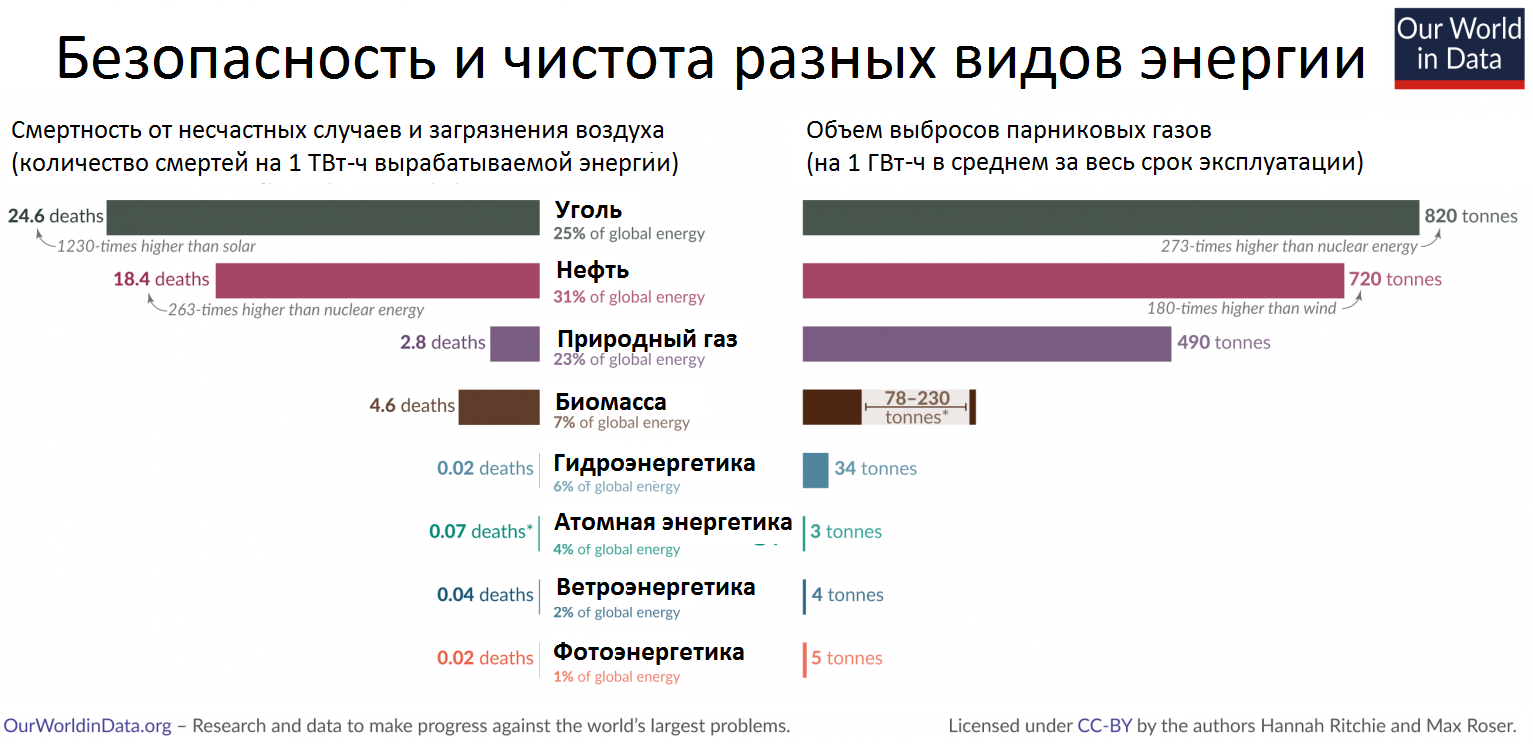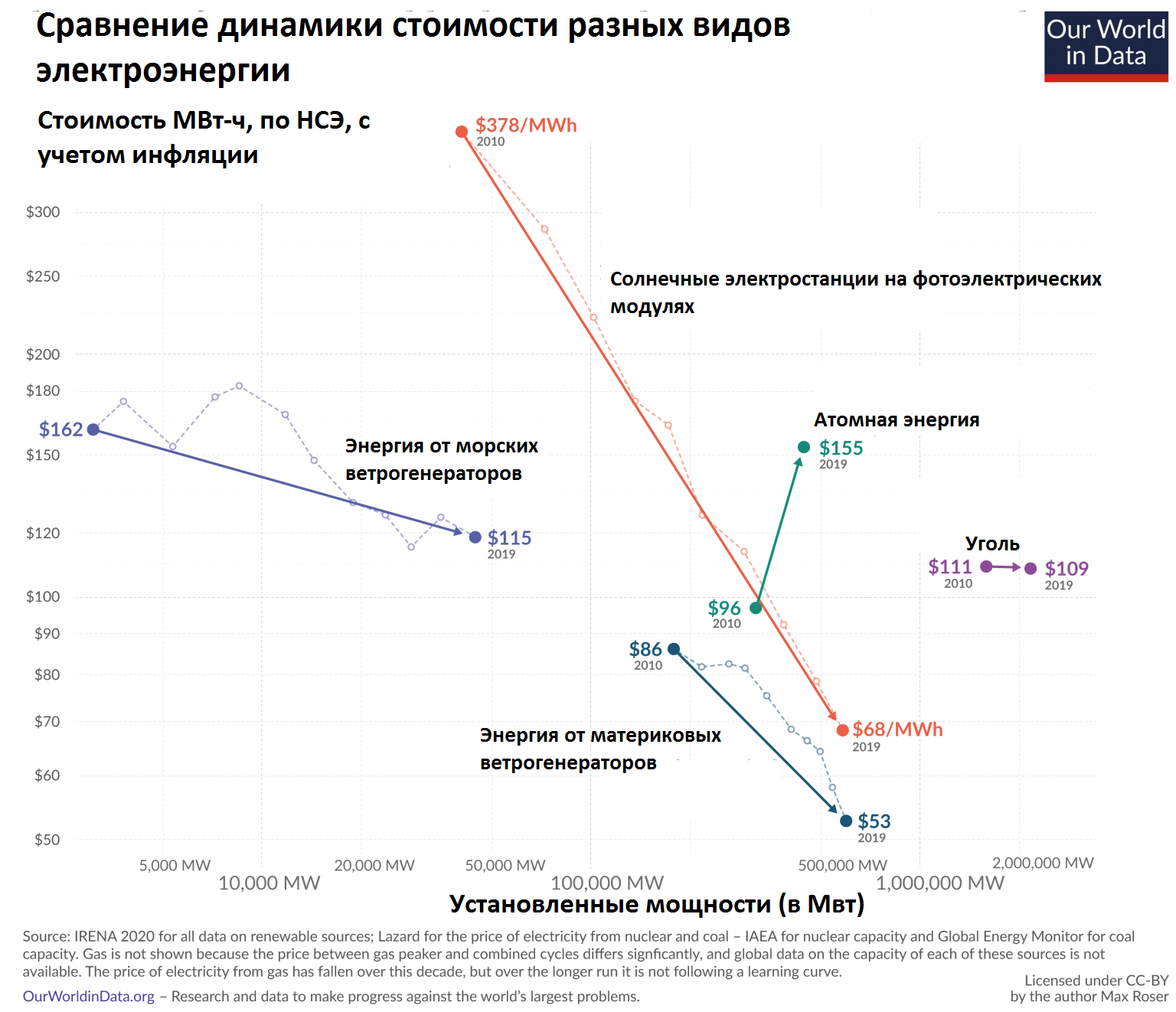
Some 10-15 years ago, “green energy” seemed like entertainment for rich and wealthy countries: the cost of energy generated by windmills and solar power plants was incomparably higher than the cost of a kilowatt-hour obtained from burning fossil fuels. Reducing the greenhouse effect, minimizing emissions and other arguments in favor of ecology often receded into the background, as soon as it came to the economic component: after all, what's the point of starting the construction of a solar station if the energy from it will be much more expensive than, for example, from coal ...
However, then a quiet revolution took place before our eyes. Over the past 10 years, the cost of energy from renewable sources has dropped several times and equaled traditional energy (and even became lower!), While the price of energy from fossil fuels remained at about the same level, and in the case of nuclear energy, on the contrary , generally increased.
Why is green energy getting cheaper so rapidly? And what can this process lead to? We have selected the most important from the publication of Max Roser, editor of the portal Our World in Data.
Price as a determining factor

Diagram 1. Original image.
Today, fossil fuels - coal, oil and gas - account for about 79% of the world's energy production. And this has serious negative consequences: the infographic above compares the death rate of the population due to air pollution (left) and the amount of greenhouse gases produced (right).
The burning of fossil fuels accounts for 87% of all global CO2 emissions, and this endangers not only the lives of our descendants, but the entire biosphere as a whole. And this is the reason for the death of many people in our time: every year from these emissions die3.6 million people worldwide. This is six times more than the death rate from murder, war and terrorist attacks combined.
It is clear from Chart 1 that alternatives to fossil fuels such as renewable energy sources (RES) and nuclear power are orders of magnitude safer and cleaner.
But why, then, does the global economy still rely on fossil fuels?
The answer is simple: the reason is that this particular type of fuel has remained the cheapest for a long time. Cheaper than all other energy sources. It is because of this that today coal still provides 37% of the world's electricity. Gas is in second place (24%). And together they are the largest source of the greenhouse effect, contributing 30% of all global emissions.

Diagram 2. Original image .
Chart 2 shows how much the price of electricity from non-renewable sources has changed over the past decade. For objectivity and clarity, the cost is expressed in “normalized cost of electricity” (NSE, LCOE). NSE is the average estimated cost of electricity production over the entire life cycle of a power plant (including all possible investments, costs and revenues). The NSE takes into account the cost of building the power plant itself, as well as the current fuel and operating costs for the entire period of operation. Thus, if the NSE of your power plant is higher than that of others, you will have to work very hard to find a buyer for your expensive electricity and, with a high probability, you will abandon this idea in favor of an economically more profitable option.
As can be seen from Diagram 2, over the past 10 years, nuclear energy has risen in price, gas has fallen in price, and the price of coal has remained almost unchanged. What is behind these charts - we will see a little later.

Diagram 3. Original image.
Diagram 3 shows the same graph, but with one important addition: it shows the dynamics of the decline in the cost of electricity from renewable sources (note that all prices were calculated excluding subsidies). Look at how the situation with the cost of renewable energy has radically changed in recent years. Literally “yesterday”, 10 years ago, it was much cheaper and more rational to build another coal power plant than to bother with solar or wind generators. "Wind" was more expensive than coal by 22%, and "sun" - by as much as 223%.
However, a lot has changed over the past 10 years. In 2009, electricity from photovoltaic installations cost $ 359 per MWh, and now it is 89% less. And the most interesting thing: now, in order to recoup the cost of building a new coal-fired power plant, you will have to charge end users a higher price for energy than if you build a wind or solar power plant of the same capacity.
This is a truly fundamental change - and of course it has had an impact on the power industry. In recent years, wind and solar energy has developed rapidly: in 2019, it was renewable energy that accounted for 72% of all new capacities put into operation.
But why is this happening? How did green energy manage to achieve such a rapid cost reduction?
The fact is that the costs of producing energy from fossil sources (as well as nuclear energy) are essentially influenced by two factors:
- the cost of the fuel itself;
- operating costs of the power plant.
In contrast, renewable energy sources have “free” fuel: they do not need to be mined and transported. And the operating costs are significantly lower. The main factor that determines the cost of renewable energy is the production technology itself .
From cosmic prices to mass market
Let's make a short excursion into the past and remember what way the photovoltaic industry went. One of the first mentions of the cost of solar electricity dates back to 1956. Then it was $ 1,865 per watt (in 2019 prices and adjusted for inflation). But one watt is about nothing. A conventional modern solar panel installed on the roof of a house produces about 320 watts, and at that price in 1956 it would have cost us as much as $ 596,800. Of course, there was no question of any competitiveness.
But thanks to space exploration. Thanks to them, the first practical application of solar energy took place: in 1958, the American satellite "Avangard-I" and the Soviet "Sputnik-3" were supplied with a solar battery. Throughout the 1960s, the space industry remained the main consumer of photovoltaics. Demand grew - and production also grew, and technologies were gradually optimized. As a result, the cost of solar modules, albeit slowly, steadily declined.
In the 1970s, "space technology" finally came down to Earth. The first ground-based applications of solar panels were attempts to electrify hard-to-reach places that were too expensive to connect to conventional power grids: lighthouses, railway crossings, etc. The top-left point in Chart 4 is the cost of one watt in 1976: $ 112 (adjusted for inflation). Note that the total global solar power generation at that time was around 0.3 MW. This, of course, was already an unheard of progress (compared to 1956, the price dropped by 94%!), But 0.3 MW is, alas, still far from an industrial scale.

Diagram 4. Original image .
But in fact, everything was just beginning ... The graph in Diagram 4, in which both scales (axes) are logarithmic, clearly demonstrates how, year after year, up to our time, the price of solar panels passed along the "learning curve": while commissioning of new capacities grew exponentially - the cost of solar modules was exponentially decreasing. The wider production became, the cheaper the production cost, and this, in turn, led to an even greater increase in production - this is the same economies of scale that we find almost everywhere. Plus, of course, government support helped, which, due to subsidies, was able to reduce the price at the earliest, most expensive stages.
The advances that have made such a reduction in the price of solar panels possible affect, in fact, the entire manufacturing process. Businesses have become larger and more efficient; R&D has become more effective; the production of silicon wafers was improved; the scale of extraction of raw materials expanded; modules became stronger and more durable; competition developed; reduced capital costs of production. These and many other big and small improvements shaped the overall process that led to continuous cost savings.
If we take the rate of cost reduction as production doubles as a kind of “learning rate”, then in the case of solar panels this figure was 20.2%. Manufacturing technology quickly became cheaper, and between 1976 and 2019, the cost of batteries fell from $ 106 to $ 0.38 per watt generated. A similar exponential change in the "learning curve" is well known to us from other technologies: the most famous example is the cost of computers (processors) and the famous "Moore's law" .
But we are more interested in prices not for solar panels, but for the actual electricity generated by them. Figure 5 compares non-renewable energy (nuclear and coal) versus renewable energy (solar, onshore and offshore wind).

Diagram 5. Original image.
This graph is also logarithmic, and it shows that the “learning curve” we saw in the case of a fall in solar panel prices is repeating here as well. The cost of green electricity declines exponentially as its production rises. With each doubling of production, the cost of 1 watt is reduced by 36% (for solar power) and 23% (onshore wind power). But energy from offshore wind turbines is still relatively expensive - only a quarter cheaper than nuclear power and slightly more expensive than coal. However, experts expect a rapid decline in the cost of this type of energy in the next few years, primarily due to larger turbines and higher utilization due to constant wind.
Thus, the production of electricity from renewable energy sources demonstrates the dynamics of a rapid and steady decline. What about traditional energy?
World coal price from 2010 to 2019 decreased from $ 111 to $ 109, i.e. by only 2% - against the background of the fact that the reduction in the cost of solar was 89%, and wind - 70%. The stagnation in coal-fired electricity prices over the past 10 years is not surprising. Historically, the dynamics of its cost has never followed the "learning curve": it was and remains relatively cheap. But it will not become much cheaper anymore. First, modern coal-fired power plants have little room for significant efficiency gains: the most efficient enterprises achieve an efficiency of 47%, and on average it is about 33%. Secondly, the price of coal-fired electricity is largely shaped by the costs of raw materials that are consumedup to 40% of total production costs. Even if the price for the construction of coal-fired power plants decreases significantly, and their efficiency increases, the price of fuel will still block the dynamics of cost reduction.
But the price of electricity from gas, on the contrary, has decreased by 32% over the past 10 years, to $ 56 per MWh. One of the reasons is the reduction in the construction cost of processing plants. But another reason is much more important: a significant decrease in the price of gas itself as a raw material after the peak in cost in 2008, including due to an increase in supply with hydraulic fracturing technology. However, this decline in raw material prices is temporary: the price of gas is actually higher today. than two or three decades ago. It is unlikely that it will continue in the future, and, obviously, there is no need to talk about any "learning curve" in relation to the cost of gas electricity.
Nuclear power, as can be seen from Diagram 5, has generally risen in price, and this trend will continue in the long term. Building nuclear power plants has become more expensive, including because the industry has tightened regulation. In addition, in recent years, not so many new nuclear power plants have been built in the world, and as a result, there has been no economies of scale. Therefore, the average world cost of nuclear energy (like NSE) has generally increased. Which, however, does not negate the rather large spread in price trends between individual countries and regions. For example, if in the USA and Great Britain the prices and construction period of the stations have increased significantly, in France and South Korea they remained at the same level. According to a number of experts, countries where the construction of reactors is most standardized has managed to avoid a jump in prices. If standardization becomes widespread and the growth in the number of new nuclear power plants ceases to stagnate, then there is a possibility that the cost of nuclear power will decline.It is unlikely that it will ever reach the exponential dynamics of the cost of renewable energy, but it will be able to effectively complement renewable energy where the latter faces problems. Plus, do not forget about the possible prospects for thermonuclear reactors, which theoretically can completely change the world power supply system.
Conclusion
So why are renewables getting cheaper so quickly? As follows from the above arguments, the main feature that fundamentally distinguishes RES from fossil fuels is that their cost follows an exponential “learning curve”. Power plants using renewable sources do not require fuel costs and are relatively inexpensive to operate and maintain. Their price (NSE) depends solely on the cost of technology. And these technologies - be they solar, wind or storage technologies - follow a learning curve: each doubling of capacity leads to a corresponding reduction in costs. The more widespread wind and photovoltaic generators become, the faster their cost decreases.
Thus, the more green energy we introduce today, the more, due to cost reduction, we will be able to introduce tomorrow. Accordingly, by expanding the use of renewable energy sources, we will simultaneously solve two problems: we will reduce the negative consequences of emissions and the greenhouse effect and, perhaps even more importantly, we will get cheaper electricity. And this, ultimately, will lead to an increase in real incomes of the population, economic growth and poverty reduction.
